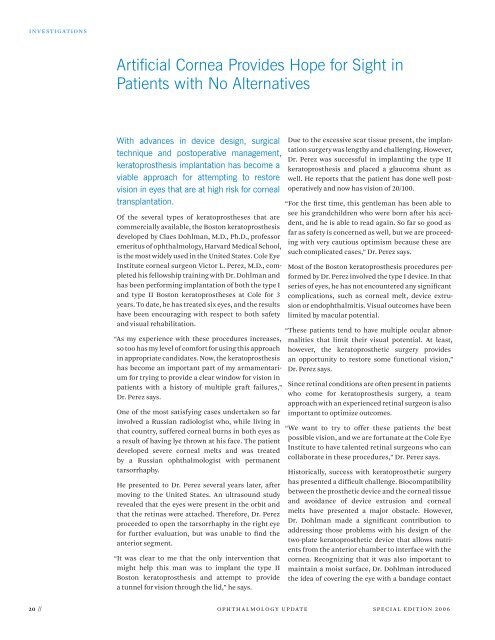Ophthalmology Update - Cleveland Clinic
Ophthalmology Update - Cleveland Clinic
Ophthalmology Update - Cleveland Clinic
Create successful ePaper yourself
Turn your PDF publications into a flip-book with our unique Google optimized e-Paper software.
i n v e s t i g a t i O n s<br />
Artificial Cornea Provides Hope for Sight in<br />
Patients with No Alternatives<br />
With advances in device design, surgical<br />
technique and postoperative management,<br />
keratoprosthesis implantation has become a<br />
viable approach for attempting to restore<br />
vision in eyes that are at high risk for corneal<br />
transplantation.<br />
Of the several types of keratoprostheses that are<br />
commercially available, the Boston keratoprosthesis<br />
developed by claes dohlman, m.d., ph.d., professor<br />
emeritus of ophthalmology, harvard medical school,<br />
is the most widely used in the United states. cole eye<br />
institute corneal surgeon victor l. perez, m.d., completed<br />
his fellowship training with dr. dohlman and<br />
has been performing implantation of both the type i<br />
and type ii Boston keratoprostheses at cole for 3<br />
years. to date, he has treated six eyes, and the results<br />
have been encouraging with respect to both safety<br />
and visual rehabilitation.<br />
“as my experience with these procedures increases,<br />
so too has my level of comfort for using this approach<br />
in appropriate candidates. now, the keratoprosthesis<br />
has become an important part of my armamentarium<br />
for trying to provide a clear window for vision in<br />
patients with a history of multiple graft failures,”<br />
dr. perez says.<br />
One of the most satisfying cases undertaken so far<br />
involved a russian radiologist who, while living in<br />
that country, suffered corneal burns in both eyes as<br />
a result of having lye thrown at his face. the patient<br />
developed severe corneal melts and was treated<br />
by a russian ophthalmologist with permanent<br />
tarsorrhaphy.<br />
he presented to dr. perez several years later, after<br />
moving to the United states. an ultrasound study<br />
revealed that the eyes were present in the orbit and<br />
that the retinas were attached. therefore, dr. perez<br />
proceeded to open the tarsorrhaphy in the right eye<br />
for further evaluation, but was unable to find the<br />
anterior segment.<br />
“it was clear to me that the only intervention that<br />
might help this man was to implant the type ii<br />
Boston keratoprosthesis and attempt to provide<br />
a tunnel for vision through the lid,” he says.<br />
due to the excessive scar tissue present, the implantation<br />
surgery was lengthy and challenging. however,<br />
dr. perez was successful in implanting the type ii<br />
keratoprosthesis and placed a glaucoma shunt as<br />
well. he reports that the patient has done well postoperatively<br />
and now has vision of 20/100.<br />
“For the first time, this gentleman has been able to<br />
see his grandchildren who were born after his accident,<br />
and he is able to read again. so far so good as<br />
far as safety is concerned as well, but we are proceeding<br />
with very cautious optimism because these are<br />
such complicated cases,” dr. perez says.<br />
most of the Boston keratoprosthesis procedures performed<br />
by dr. perez involved the type i device. in that<br />
series of eyes, he has not encountered any significant<br />
complications, such as corneal melt, device extrusion<br />
or endophthalmitis. visual outcomes have been<br />
limited by macular potential.<br />
“these patients tend to have multiple ocular abnormalities<br />
that limit their visual potential. at least,<br />
however, the keratoprosthetic surgery provides<br />
an opportunity to restore some functional vision,”<br />
dr. perez says.<br />
since retinal conditions are often present in patients<br />
who come for keratoprosthesis surgery, a team<br />
approach with an experienced retinal surgeon is also<br />
important to optimize outcomes.<br />
“We want to try to offer these patients the best<br />
possible vision, and we are fortunate at the cole eye<br />
institute to have talented retinal surgeons who can<br />
collaborate in these procedures,” dr. perez says.<br />
historically, success with keratoprosthetic surgery<br />
has presented a difficult challenge. Biocompatibility<br />
between the prosthetic device and the corneal tissue<br />
and avoidance of device extrusion and corneal<br />
melts have presented a major obstacle. however,<br />
dr. dohlman made a significant contribution to<br />
addressing those problems with his design of the<br />
two-plate keratoprosthetic device that allows nutrients<br />
from the anterior chamber to interface with the<br />
cornea. recognizing that it was also important to<br />
maintain a moist surface, dr. dohlman introduced<br />
the idea of covering the eye with a bandage contact<br />
0 // O p h t h a l m O l O g y U p d a t e s p e c i a l e d i t i O n 2 0 0 6
















